Allowing Users to Benefit from Tree Shading: Using a Smartphone App to Allow Adaptive Route Planning during Extreme Heat
Abstract
1. Introduction
2. Classification of Shadeways
3. Systematic Review of Smartphone Apps and Scholarly Literature
4. Future Shadeways
4.1. Concept of Our Project
4.2. Study Area
4.3. Understanding Shading from a Citizen User Perspective
4.4. Results and Discussion
4.4.1. Focus Groups
“I am conscious of the heat, particularly for gardening, like I’ll put that off as an activity into the evening so I garden a lot I feel like I’m always aware of the heat because I’m always thinking about it in relation to the plants.”
“Walking the dog, you’ve got to do that early. before lunch, 9.”
“if there’s an activity I want to go to whether it’s work or something with my children, and it’s too close not to walk... just have to walk, and just manage that in carrying water and hats and things.”
“I like to walk, I, I prefer to park on the periphery and walk, but when it’s hot, it. you’ve got to think all that through even clearer.”
“I drive a bit too I must say, if it’s a hot day, yeah, I just get in the car and drive.”
“Sites such as Kennington Reservoir were recognised for the comfort provided by shade (Kennington Res) is attractive because you can run around and you’re in shade most of the way around. Unless you do the boardwalk bit, but if you do the full circle there’s very little sunshine.”
“I’ve taken a few different like, side streets and bits that are like, off Google Maps, that I’ve just been able to kind of sus out on my way home, when I have a little bit of extra time to explore. it’s more comfortable isn’t it, when you’re cooler, so choose the shady routes. Unless you are running late”.
“They provide an incredible amount of shade, [but], if we start doing more plantings for streets, you know so people can have shady areas, we’re looking at a 20-year turnover.”
“I love the bush tracks as well but they always, it’s complicated because it’s not, you see either or their dryness in a way, so they, they always feel hotter.”
“If you go to Mildura, it’s shade, shade. all the car parks have them everywhere, Mildura’s really onto it.”
“We’re now getting heat like Cairns used to get, and you go up there, and everything’s under shade, and I’m talking about artificial shade - I don’t care what the shade is. and that’s the way it’ll go.”
“Some days you can handle the heat because the glare’s not as strong.”
4.4.2. Results from the Handheld Device
5. Conclusions
Author Contributions
Funding
Conflicts of Interest
References
- Kjellstrom, T.; Butler, A.J.; Lucas, R.M.; Bonita, R. Public health impact of global heating due to climate change: Potential effects on chronic non-communicable diseases. Int. J. Public Health 2010, 55, 97–103. [Google Scholar] [PubMed]
- Lefevre, C.E.; de Bruin, W.B.; Taylor, A.L.; Dessai, S.; Kovats, S.; Fischhoff, B. Heat protection behaviors and positive affect about heat during the 2013 heat wave in the United Kingdom. Soc. Sci. Med. 2015, 128, 282–289. [Google Scholar] [CrossRef] [PubMed]
- Thompson, R.; Hornigold, R.; Page, L.; Waite, T. Associations between high ambient temperatures and heat waves with mental health outcomes: A systematic review. Public Health 2018, 161, 171–191. [Google Scholar] [CrossRef] [PubMed]
- Estrada, F.; Botzen, W.W.; Tol, R.S. A global economic assessment of city policies to reduce climate change impacts. Nat. Clim. Chang. 2017, 7, 403. [Google Scholar] [CrossRef]
- United Nations. 2018 Revision of World Urbanization Prospects; United Nations Department of Economic and Social Affairs: New York, NY, USA, 2018.
- Zhou, D.; Xiao, J.; Bonafoni, S.; Berger, C.; Deilami, K.; Zhou, Y.; Frolking, S.; Yao, R.; Qiao, Z.; Sobrino, J.A. Satellite Remote Sensing of Surface Urban Heat Islands: Progress, Challenges, and Perspectives. Remote Sens. 2019, 11, 48. [Google Scholar]
- Deilami, K.; Kamruzzaman, M.; Liu, Y. Urban heat island effect: A systematic review of spatio-temporal factors, data, methods, and mitigation measures. Int. J. Appl. Earth Obs. Geoinf. 2018, 67, 30–42. [Google Scholar] [CrossRef]
- Vardoulakis, S.; Dear, K.; Hajat, S.; Heaviside, C.; Eggen, B.; McMichael, A.J. Comparative assessment of the effects of climate change on heat-and cold-related mortality in the United Kingdom and Australia. Environ. Health Perspect. 2014, 122, 1285–1292. [Google Scholar] [CrossRef]
- Strengers, Y.; Maller, C.; Nicholls, L.; Pink, S. Australia’s rising air con use makes us hot and bothered. Conversation. 2014. Available online: https://theconversation.com/australias-rising-air-con-use-makes-us-hot-and-bothered-20258 (accessed on 11 August 2020).
- Bambrick, H.J.; Capon, A.G.; Barnett, G.B.; Beaty, R.M.; Burton, A.J. Climate change and health in the urban environment: Adaptation opportunities in Australian cities. Asia Pac. J. Public Health 2011, 23, 67S–79S. [Google Scholar] [CrossRef] [PubMed]
- Moll, G. Shading Our Cities: A Resource Guide for Urban and Community Forests; Island Press: Washington, WA, USA, 1989. [Google Scholar]
- Plant, L. Brisbane: “beautiful one day, perfect the next”-is there room for improvement. In Proceedings of the 7th National street tree symposium, Urrbrae, Australia, 1 September 2006; pp. 7–8. [Google Scholar]
- Shatu, F.M.; Kamruzzaman, M.; Deilami, K. Did Brisbane Grow Smartly? Drivers of City Growth 1991-2001 and Lessons for Current Policies. SAGE Open 2014, 4, 713. [Google Scholar] [CrossRef]
- Anthopoulos, L.G. Understanding the Smart City Domain: A Literature Review. In Transforming City Governments for Successful Smart Cities; Rodríguez-Bolívar, M.P., Ed.; Springer International Publishing: Cham, Switzerland, 2015; pp. 9–21. [Google Scholar] [CrossRef]
- Gössling, S. ICT and transport behavior: A conceptual review. Int. J. Sustain. Transp. 2018, 12, 153–164. [Google Scholar] [CrossRef]
- Rathore, M.M.; Ahmad, A.; Paul, A.; Rho, S. Urban planning and building smart cities based on the Internet of Things using Big Data analytics. Comput. Netw. 2016, 101, 63–80. [Google Scholar] [CrossRef]
- Komanduri, A.; Wafa, Z.; Proussaloglou, K.; Jacobs, S. Assessing the Impact of App-Based Ride Share Systems in an Urban Context: Findings from Austin. Transp. Res. Rec. 2018, 2672, 34–46. [Google Scholar] [CrossRef]
- Fisher, K.E.; Landry, C.F.; Naumer, C. Social spaces, casual interactions, meaningful exchanges:’information ground’characteristics based on the college student experience. Inf. Res. 2007, 12, 12. [Google Scholar]
- Sanusi, R.; Johnstone, D.; May, P.; Livesley, S.J. Microclimate benefits that different street tree species provide to sidewalk pedestrians relate to differences in Plant Area Index. Landsc. Urban. Plan. 2017, 157, 502–511. [Google Scholar] [CrossRef]
- Morakinyo, T.E.; Lam, Y.F. Simulation study on the impact of tree-configuration, planting pattern and wind condition on street-canyon’s micro-climate and thermal comfort. Build. Environ. 2016, 103, 262–275. [Google Scholar] [CrossRef]
- Sullivan, R.K.; Marsh, S.; Halvarsson, J.; Holdsworth, M.; Waterlander, W.; Poelman, M.P.; Salmond, J.A.; Christian, H.; Koh, L.S.; Cade, J.E. Smartphone apps for measuring human health and climate change co-benefits: A comparison and quality rating of available apps. JMIR Mhealth Uhealth 2016, 4, e135. [Google Scholar] [CrossRef]
- OSHA. US Department of Labor’s OSHA Releases Mobile App to Help Protect Workers from Heat-Related Illnesses. Available online: https://www.osha.gov/news/newsreleases/national/08112011-0 (accessed on 31 May 2019).
- Ma, K. Parasol Navigation: Optimizing Walking Routes to Keep You in the Sun or Shade. Available online: https://bit.ly/31FJlJ9 (accessed on 16 September 2020).
- Paris,“ I.d.f.à.” Ilots de fraîcheur à Paris. Available online: https://bit.ly/3khx6to (accessed on 16 September 2020).
- Bandini, S.; Crociani, L.; Gorrini, A.; Nishinari, K.; Vizzari, G. Walkability Assessment for the Elderly Through Simulations: The LONGEVICITY Project. In Proceedings of the 17th International Conference of the Italian Association for Artificial Intelligence, Trento, Italy, 20–23 November 2018. [Google Scholar]
- Speck, J. The General Theory of Walkability. Washingron, DC, USA, 2014. Available online: https://bit.ly/35EYbly (accessed on 16 September 2020).
- Monreal, C.O.; Pichler, M.; Krizek, G.; Naumann, S. Shadow as Route Quality Parameter in a Pedestrian-Tailored Mobile Application. IEEE Intell. Transp. Syst. Mag. 2016, 8, 15–27. [Google Scholar] [CrossRef]
- Novack, T.; Wang, Z.; Zipf, A. A system for generating customized pleasant pedestrian routes based on OpenStreetMap data. Sensors 2018, 18, 3794. [Google Scholar] [CrossRef]
- White, M.; Kimm, G.; Langenheim, N. Pedestrian Access Modelling with Tree Shade—Won’t Someone Think of the Children. Procedia Eng. 2017, 198, 139–151. [Google Scholar] [CrossRef]
- White, M.; Langenheim, N. Impact assessment of street trees in the City of Melbourne using temporal high polygon 3D canopy modelling. In Proceedings of the 7th International Urban Design Conference, Colombo, Sri Lanka, 15–17 November 2019. [Google Scholar]
- Oliveira Júnior, A.J.D.; Souza, S.R.L.D.; Dal Pai, E.; Rodrigues, B.T.; Souza, V.C.D. Aurora: Mobile application for analysis of spatial variability of thermal comfort indexes of animals and people, using IDW interpolation. Comput. Electron. Agric. 2019, 157, 98–101. [Google Scholar] [CrossRef]
- Peel, M.C.; Finlayson, B.L.; McMahon, T.A. Updated world map of the Köppen-Geiger climate classification. Hydrol. Earth Syst. Sci. Discuss. 2007, 4, 439–473. [Google Scholar] [CrossRef]
- CoGB. Community Profile. Available online: https://profile.id.com.au/bendigo/population-estimate (accessed on 10 September 2019).
- Petrunoff, N.; Rissel, C.; Wen, L.M. “If You Don’t Do Parking Management Forget Your Behaviour Change, It’s Not Going to Work.”: Health and Transport Practitioner Perspectives on Workplace Active Travel Promotion. PLoS ONE 2017, 12, e0170064. [Google Scholar] [CrossRef] [PubMed]
- Lusk, A.C.; da Silva Filho, D.F.; Dobbert, L. Pedestrian and cyclist preferences for tree locations by sidewalks and cycle tracks and associated benefits: Worldwide implications from a study in Boston, MA. Cities 2018. [Google Scholar] [CrossRef]
- Klemm, W.; Heusinkveld, B.G.; Lenzholzer, S.; Jacobs, M.H.; Van Hove, B. Psychological and physical impact of urban green spaces on outdoor thermal comfort during summertime in The Netherlands. Build. Environ. 2015, 83, 120–128. [Google Scholar] [CrossRef]
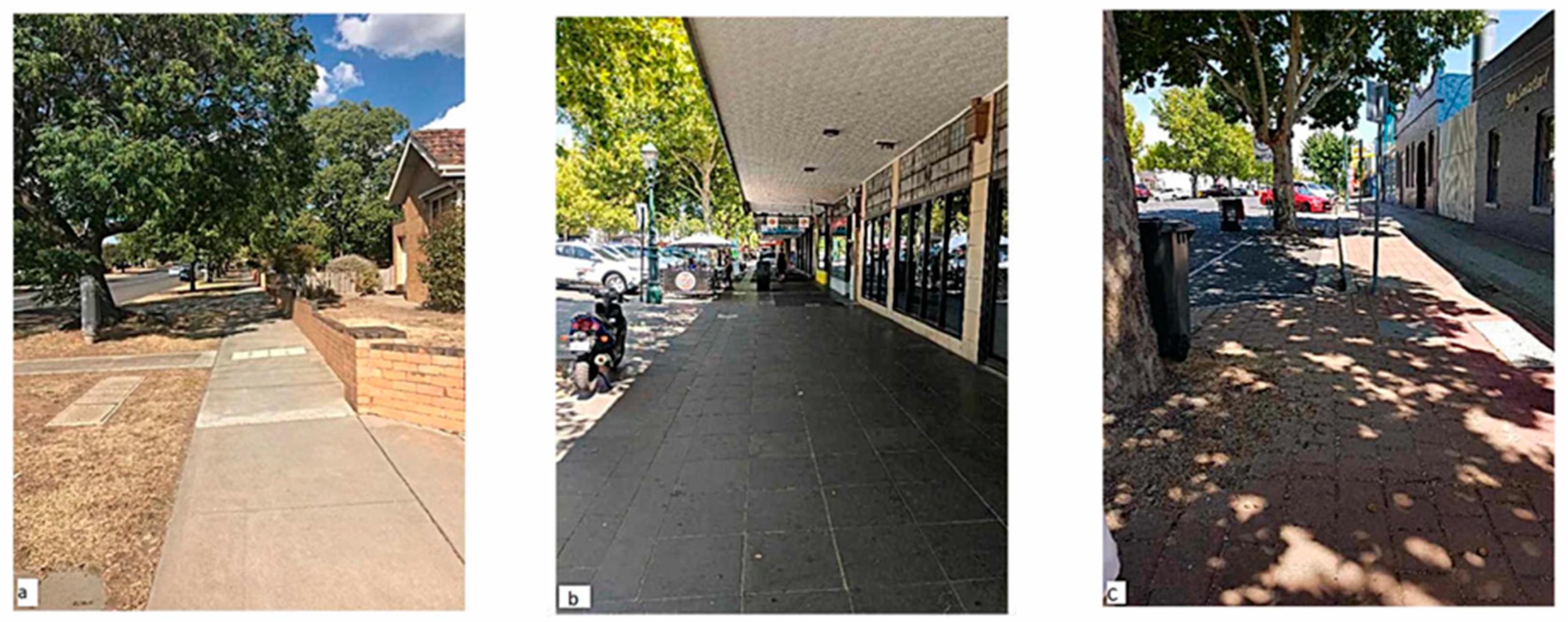
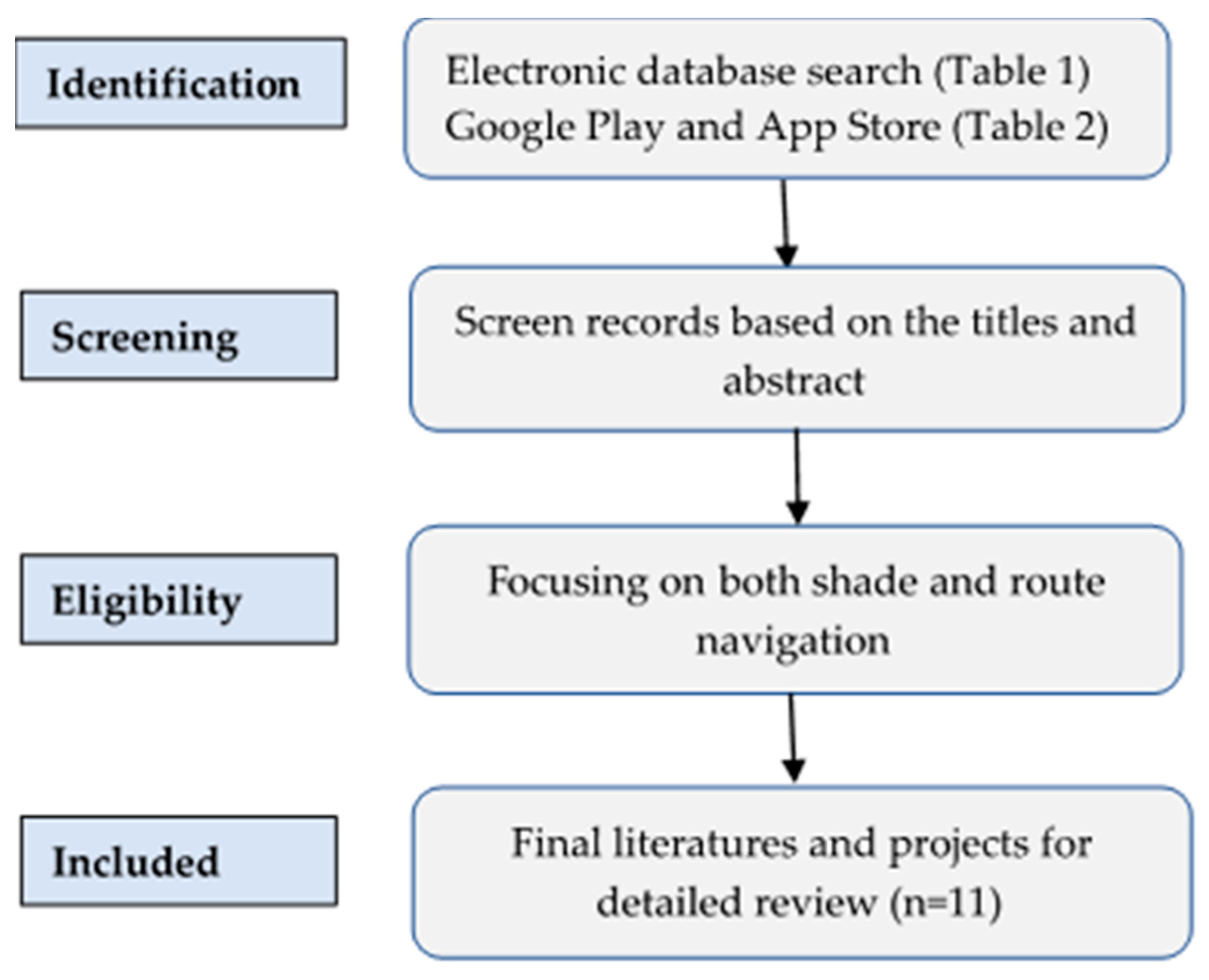
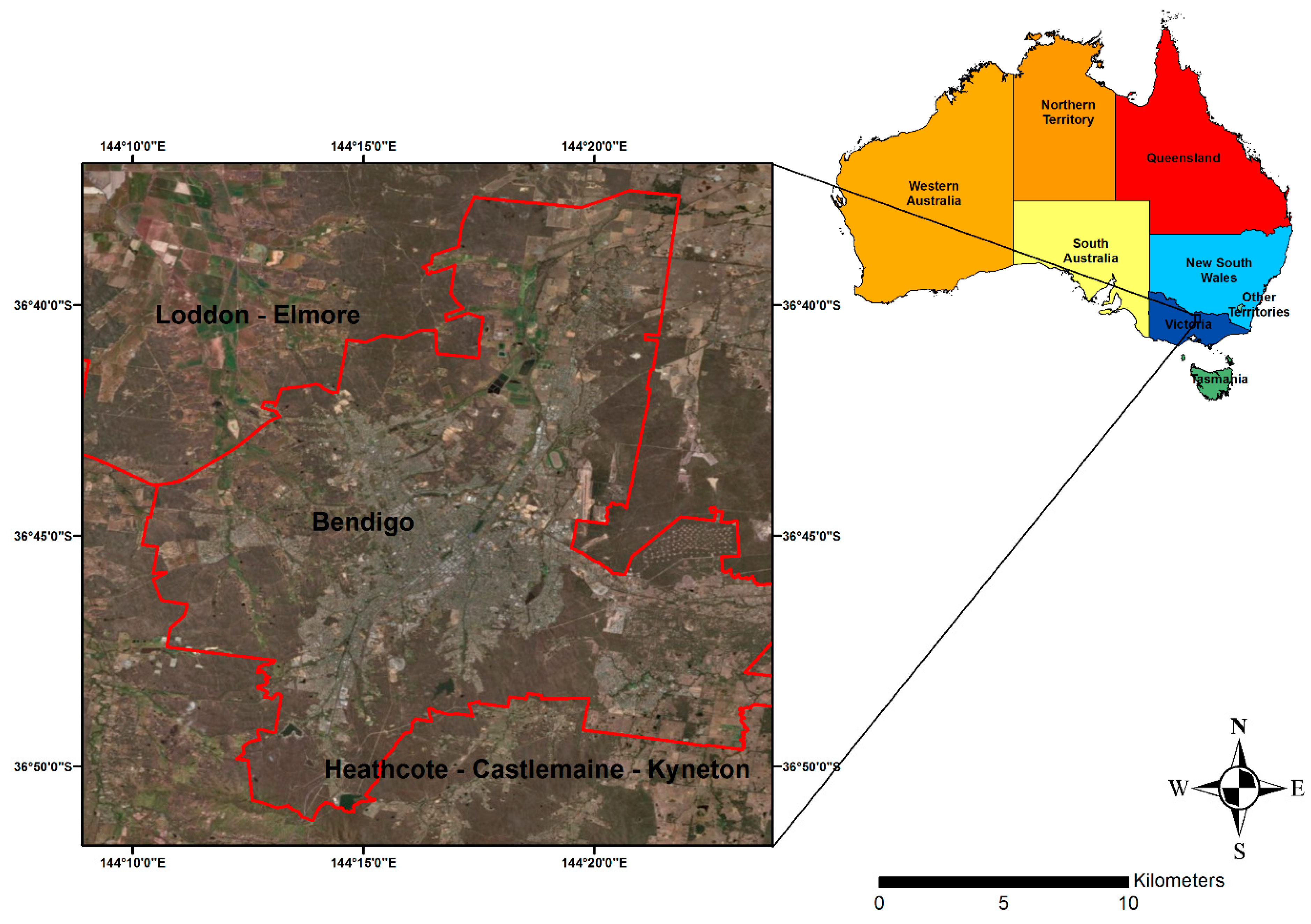
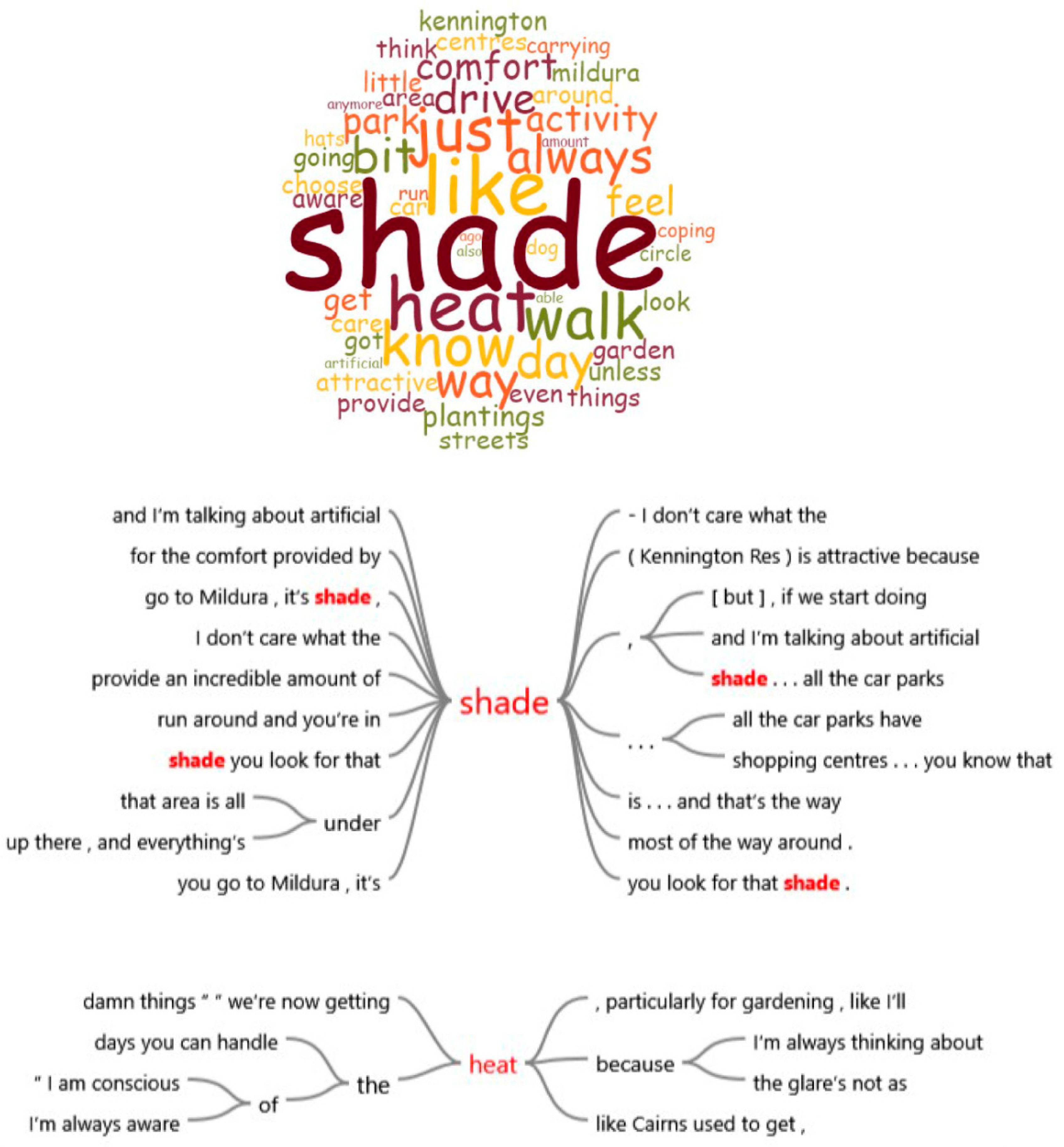
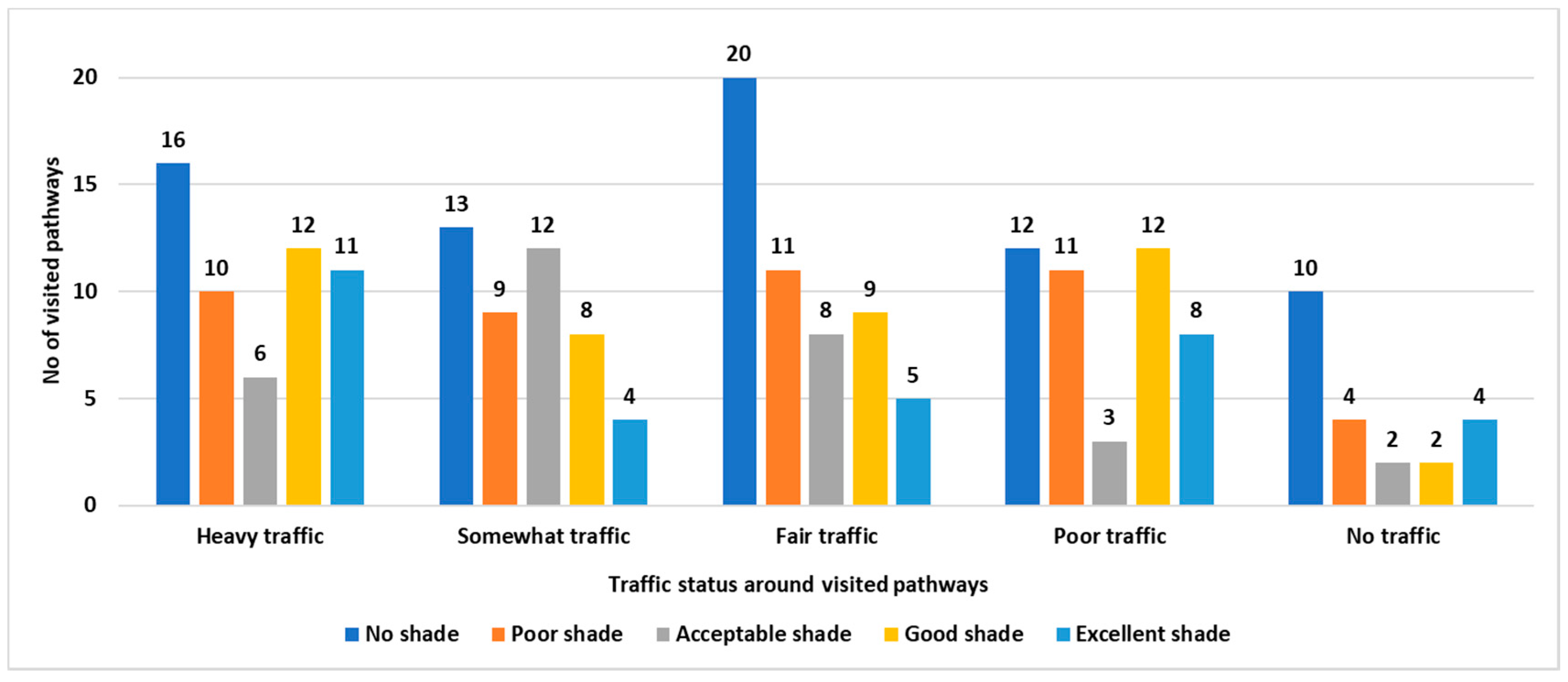
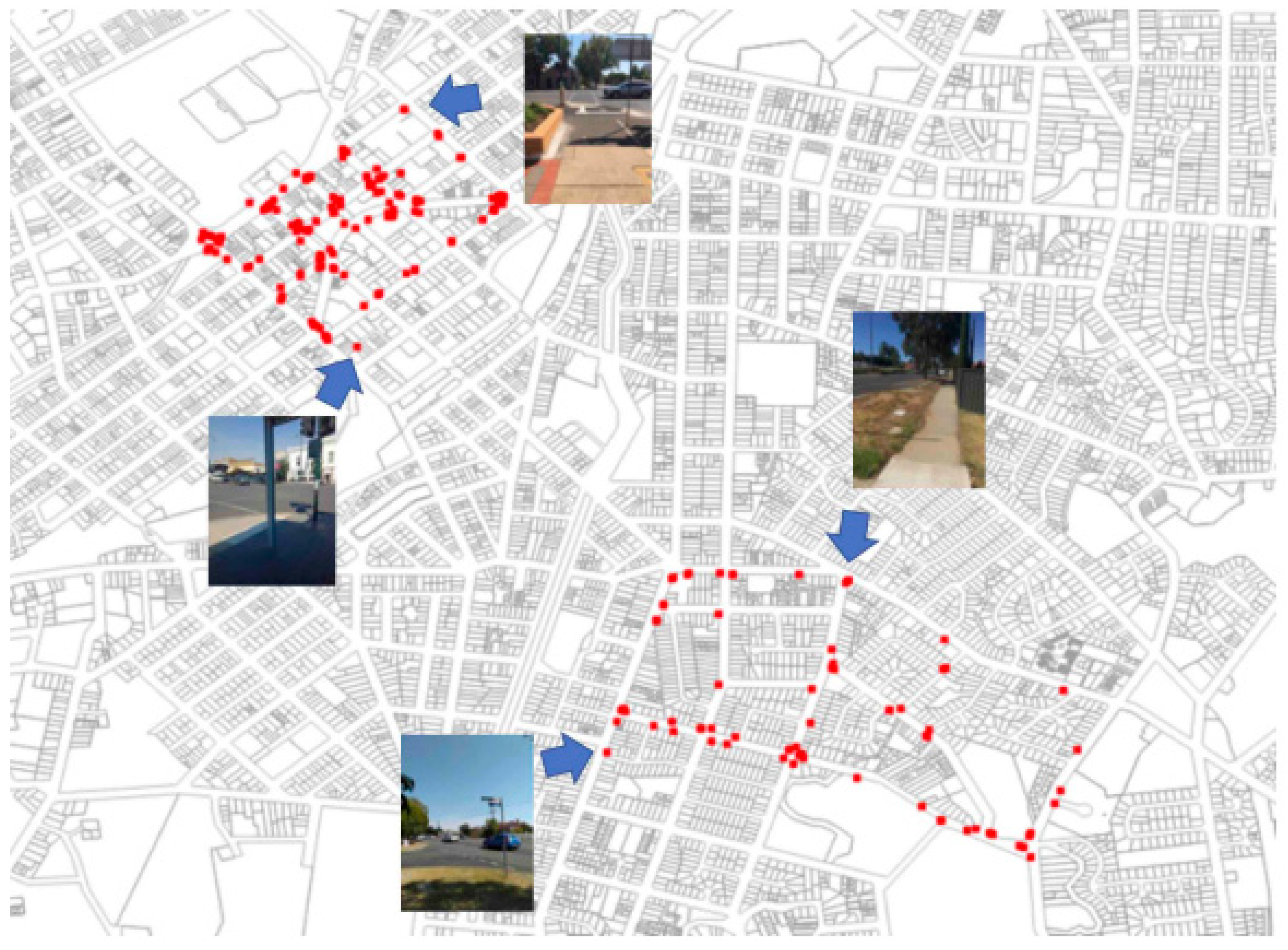
| Key words used to find the apps in Google Play and App Store |
|
| Apps categories | Health and Fitness; Get Outside; Weather; Maps and Navigation; Travel |
| Browsing time | 1 April 2019–1 July 2020 |
| Combination of keywords used to find publications for review |
|
| Document type Peer-review status | Journal articles, conference proceedings, book chapters Only peer-reviewed documents |
| Language Publication date range | English 2007–April 2019 |
| Source or Location | Digital Platform | Function | Reference |
|---|---|---|---|
| U.S Department of Labor | Smartphone app | Assisting workers to determine necessary protective measures in relation to temperature. Targeting workers and its purpose was to determine necessary protective measures using the | [22] |
| LONGEVICITY, Milan, Italy | Webpage | Decreasing the social exclusion of elderly people by enhancing their walkability in urban areas. | [25] |
| Paris | Webpage | Providing a thematic map of parks in Paris based on the amount of shade | [24] |
| Vienna, Austria | Smartphone app (Android) | Identifying route quality by focusing on shade available for pedestrians. | [27] |
| Germany | Webpage | Incorporating greenness, sociability, and quietness in a customized routing mapping system. | [28] |
| PedCatch | Webpage | Combining data about busy roads with proxy-object tree modelling in an agent-based catchment analysis model. An agent-based catchment analysis model that combines data about busy roads with proxy-object tree modelling | [29,30] |
| Parasol Navigation, Boston | Webpage | Allowing users to distinguish between sunny and shady routes | [23] |
| Aurora | Smartphone app (Android) | Providing maps of spatial variability of thermal comfort indices | [31] |
| Walkonomics Navigation and Maps | Smartphone app (Android) | Providing a rating for routes based on various criteria | Google Play Store |
| Walkspan | Smartphone app (Apple) | Providing a rating for routes based on various criteria | App Store |
| Age | Number | % |
|---|---|---|
| 0–19 Years | 37,678 | 24.61 |
| 20–39 Years | 35,004 | 22.86 |
| 40–59 Years | 40,760 | 26.62 |
| 60–79 Years | 32,074 | 20.95 |
| 80+ | 7591 | 4.96 |
| Total | 153,107 | 100.00 |
| (a) Assessment of Shadiness of the Route | Frequency | Percent | |
| Responses | No shade | 72 | 31.9 |
| Poor shade | 46 | 20.4 | |
| Acceptable shade | 31 | 13.7 | |
| Good shade | 43 | 19.0 | |
| Excellent shade | 32 | 14.2 | |
| Missing | 2 | 0.9 | |
| Total | 226 | 100.0 | |
| (b) If this Route was More Shaded would You Cycle or Walk along it More Often | Frequency | Percent | |
| Responses | No Answer | 86 | 38.1 |
| No | 24 | 10.6 | |
| Yes | 116 | 51.3 | |
| Total | 226 | 100.0 | |
| (c) Am I Comfortable with the Temperature at This Location? | Frequency | Percent | |
| Responses | Strongly disagree | 45 | 19.9 |
| Somewhat disagree | 26 | 11.5 | |
| Disagree | 29 | 12.8 | |
| Neither agree nor disagree | 11 | 4.9 | |
| Agree | 45 | 19.9 | |
| Somewhat agree | 54 | 23.9 | |
| Strongly agree | 16 | 7.1 | |
| Total | 226 | 100 | |
| (d) Assessment the Traffic of the Route | Frequency | Percent | |
| Responses | Heavy traffic | 56 | 24.8 |
| Somewhat traffic | 46 | 20.4 | |
| Fair traffic | 54 | 23.9 | |
| Poor traffic | 46 | 20.4 | |
| No traffic | 22 | 9.7 | |
| Missing | 2 | 0.9 | |
| Total | 226 | 100.0 | |
© 2020 by the authors. Licensee MDPI, Basel, Switzerland. This article is an open access article distributed under the terms and conditions of the Creative Commons Attribution (CC BY) license (http://creativecommons.org/licenses/by/4.0/).
Share and Cite
Deilami, K.; Rudner, J.; Butt, A.; MacLeod, T.; Williams, G.; Romeijn, H.; Amati, M. Allowing Users to Benefit from Tree Shading: Using a Smartphone App to Allow Adaptive Route Planning during Extreme Heat. Forests 2020, 11, 998. https://doi.org/10.3390/f11090998
Deilami K, Rudner J, Butt A, MacLeod T, Williams G, Romeijn H, Amati M. Allowing Users to Benefit from Tree Shading: Using a Smartphone App to Allow Adaptive Route Planning during Extreme Heat. Forests. 2020; 11(9):998. https://doi.org/10.3390/f11090998
Chicago/Turabian StyleDeilami, Kaveh, Julie Rudner, Andrew Butt, Tania MacLeod, Geoff Williams, Harmen Romeijn, and Marco Amati. 2020. "Allowing Users to Benefit from Tree Shading: Using a Smartphone App to Allow Adaptive Route Planning during Extreme Heat" Forests 11, no. 9: 998. https://doi.org/10.3390/f11090998
APA StyleDeilami, K., Rudner, J., Butt, A., MacLeod, T., Williams, G., Romeijn, H., & Amati, M. (2020). Allowing Users to Benefit from Tree Shading: Using a Smartphone App to Allow Adaptive Route Planning during Extreme Heat. Forests, 11(9), 998. https://doi.org/10.3390/f11090998





